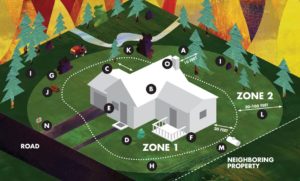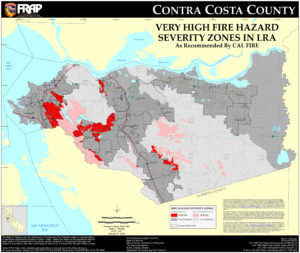Ever Changing Fire Hardening Laws Affect Property Owners, Keep Buyers at Bay and Open Up to Potential Lawsuits
As Californians face larger and more intense wildfires, the laws have adapted in response. In the 2021 updates, the California state legislature enacted more proactive measures to combat the growing wildfire threat. This will impact more than two million California households and a quarter of residential structures that are located within or near a “high” or “very high” fire hazard severity zone. Understanding these changes will help inform and advise clients on how to comply and mitigate the risk of losing their home or investment and of incurring liability from fines or lawsuits.
What changed?
Prior to 2021, it was already a crime for a person who owns, leases, manages, controls, operates or maintains an occupied dwelling or structure to fail to maintain a 100 feet defensible space on all sides of the structure.[1] Insurance companies also have a right to require a greater distance than the State Board of Forestry and Fire Protection (“State Board”).[2] Since 2010, California building codes required all new home construction to incorporate fire hardening features in high or very high fire severity zones. The Department of Forestry and Fire Protection (“Department”) was also tasked with providing an online guidance on fuel management.[3] But these regulations did not go far enough.
AB3074 was passed in late 2020 to require more intense fuel reductions within five to 30 feet around the structure, also known as the “ember-resistant zone requirements,” and it put into place a notice and enforcement mechanism.[4] The bill also requires the State Board to provide suggestions for creating an ember-resistant zone within five feet of a structure.[5] It may just be a matter of time before these mere suggestions or recommendations become expensive retrofit mandates, and so it is imperative that we keep an eye on these legal developments.
 AB38 further requires all sellers of dwellings located in the very high fire hazard severity zone to complete a Fire Hardening Disclosure. Such sellers must disclose whether the home has fire hardening features such as fire-retardant roof shingles, roof vents, rain gutters with metal coverings and tempered glass windows among other things. Seller must also obtain documentation that they have maintained fire hardening features.[6] If such documentation doesn’t currently exist, then the burden is on the buyer to obtain such documentation within one year of the close of escrow.[7] Sellers must also disclose whether the property is constructed before January 1, 2020, whether they are aware of any property features that increase the risk of fire, and whether they received a home fire hardening final inspection report.[8] The ever-changing nature of these fire hardening regulations and reforms could detract buyers. But these costs may be a small price to pay to reduce the risk of wildfire damage.
AB38 further requires all sellers of dwellings located in the very high fire hazard severity zone to complete a Fire Hardening Disclosure. Such sellers must disclose whether the home has fire hardening features such as fire-retardant roof shingles, roof vents, rain gutters with metal coverings and tempered glass windows among other things. Seller must also obtain documentation that they have maintained fire hardening features.[6] If such documentation doesn’t currently exist, then the burden is on the buyer to obtain such documentation within one year of the close of escrow.[7] Sellers must also disclose whether the property is constructed before January 1, 2020, whether they are aware of any property features that increase the risk of fire, and whether they received a home fire hardening final inspection report.[8] The ever-changing nature of these fire hardening regulations and reforms could detract buyers. But these costs may be a small price to pay to reduce the risk of wildfire damage.
Who is affected?
Owners of “occupied” dwellings or structures in a “very high fire hazard severity zone”[9] must comply with the ember-resistant zone requirement.[10] This would include landlords, property managers, and business owners; and it may apply to tenants if the lease puts the burden on them to maintain the structure and landscaping.[11] This new law also applies to any “structure,” such as commercial buildings, hotels, barns and stables, just as long as they are not vacant. Most recently, the definition of a structure was expanded to include decks.[12]

When do these regulations take affect?
The ember-resistant zone requirement took effect January 1, 2021, and it will continue as long as the State Board promulgates the requirement, and the Legislature appropriates funding in its annual budget.[13] The fire hardening disclosure requirement also took effect on January 1, 2021. No later than January 1, 2023, the State Board will issue further guidance on how to create an ember-resistant zone within five feet of a structure.
What are the consequences for non-compliance?
Aside from possibly losing one’s property, failure to comply with a notice of abatement could result in a government priority lien, making it difficult for owners to sell or refinance their property.[14] In addition, the first infraction is punishable by a fine of $100 to $500.[15] If another violation occurs within five years, the fine increases to a range of $250 to $500. If convicted of a third violation, then a misdemeanor could result which is punishable by a fine of not less than $500, in addition to being billed for the costs incurred by the local agency to perform the necessary work.[16] Insurance companies could cancel their policy or deny claims upon learning that the owner failed to act upon a notice of abatement, making it more difficult for the owner to rebuild in the event of a total loss due to fires.
Failure to comply could also lead to negligence claims, if the cause or spread of the wildfire is attributed to the failure to create an ember-resistant zone around a given property. The fact that PG&E has an easement on the property and a duty to maintain the utility lines on such properties does not absolve the property owners from these statutory violations.[17] These statutes work in tandem to make sure that if either owner or PG&E fails to maintain the trees or shrub around the utility lines, then the other is responsible for performing the work.[18]
Exemptions from fire hardening mandates
An exemption may be granted if owners retrofit their property to make them more fire resistant. Dwellings and structures that are entirely constructed on the exterior of nonflammable materials, which was required for homes built since 2010, may be exempt from the ember resistant zone requirement, but the owner must first file an application with the Department and get its written consent for the exemption.19 Another option is to keep the property vacant. It will be interesting to see if these more aggressive mandates will reduce property damage and deaths due to wildfires each year.
[1] Government Code Section 51182(a)(1)(A); Public Resources Code Section 4291(a)(1)(A).
[2] Public Resources Code Section 4291(a)(1)(A)(C).
[3] Government Code Section 51182(c)(1).
[4] Government Code Sections 51182(a)(1)(A), 51186(b)(1); Public Resources Code Section 4291(a)(1)(A), (f)(1)(B).
[5] Government Code Section 51182(c)(2). The following list of features have been codified to put property owners on notice of what fire hazard vulnerabilities exist in a home:
(A) Eave, soffit, and roof ventilation where the vents have openings in excess of one-eighth of an inch or are not flame and ember resistant.
(B) Roof coverings made of untreated wood shingles or shakes.
(C) Combustible landscaping or other materials within five feet of the home and under the footprint of any attached deck.
(D) Single pane or nontempered glass windows.
(E) Loose or missing bird stopping or roof flashing.
(F) Rain gutters without metal or noncombustible gutter covers. Civil Code Section 1102.6f(a)(3).
[6] Public Resources Code Section 4291.
[7] Civil Code Section 1102.19.
[8] Civil Code Section 1102.6f.
[9] To find out if a particular property is located in a high or very high fire hazard severity zone (pictured above in red for Contra Costa County), visit the following website: osfm.fire.ca.gov.
[10] Government Code Section 51182(a).
[11] Government Code Section 51182(b) specifically states that a person is not required to manage fuels on land if they don’t have a legal right to, or consent from the owner. This would give some statutory protections to tenants and adjoining landowners who may have been given notice of a fire prone hazardous condition, but could not and did not act due to lack of consent from the property owner.
[12] Government Code Section 51182(d).
[13] Government Code Section 51182(a), Public Resources Code Section 4292(a)(1)(A).
[14] Government Code Sections 51186 and 51189(d)(2).
[15] Public Resources Code Section 4291.
[16] Public Resources Code Section 4291.1.
[17] Public Resources Code Sections 4291-4293.
[18] Public Resources Code Sections 4291, 4295.5.
[19] Public Resources Code Section 4291(c)(1).
MCLE SELF STUDY
Earn one hour of MCLE credit by answering the questions on the Self Study MCLE test available here.
Send your answers along with a check ($30 per credit hour for CCCBA members/ $45 per credit hour for non-members), to the address on the test form. Certificates are processed within two weeks of receipt. If you prefer to receive the test form via email, contact Anne K. Wolf at awolf@cccba.org or (925) 370-2540.